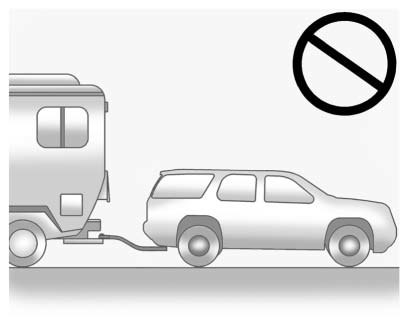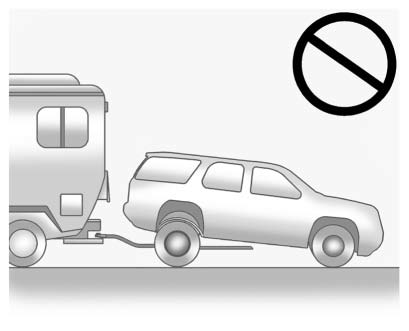Buick Enclave: Towing the Vehicle. Recreational Vehicle Towing
Notice: To avoid damage, the disabled vehicle should be towed with all four
wheels off the ground. Care must be taken with vehicles that have low ground clearance
and/or special equipment. Always flatbed on a car carrier. Consult your dealer or a professional towing service if the disabled vehicle
must be towed. See Roadside Assistance Program (U.S. and Canada) or Roadside Assistance
Program (Mexico) . To tow the vehicle behind another vehicle for recreational purposes, such as
behind a motor home, see “Recreational Vehicle Towing” in this section. Recreational vehicle towing means towing the vehicle behind another vehicle –
such as behind a motorhome. The two most common types of recreational vehicle towing
are known as dinghy towing and dolly towing. Dinghy towing is towing the vehicle
with all four wheels on the ground. Dolly towing is towing the vehicle with two wheels on the ground and two wheels
up on a device known as a dolly. Here are some important things to consider before recreational vehicle towing: Be sure to read the tow vehicle manufacturer's recommendations. Dinghy Tow If the vehicle is front-wheel-drive, it can be dinghy towed from the front. These vehicles may also be towed by putting the front wheels on a dolly. See
“Dolly Towing” later in this section. If the vehicle is all-wheel-drive, it can be dinghy towed from the front. These vehicles can also be towed by placing them on a platform trailer with all
four wheels off of the ground. These vehicles cannot be towed using a dolly. For vehicles being dinghy towed, the vehicle should be run at the beginning of
each day and at each RV fuel stop for about five minutes. This will ensure proper lubrication of transmission components. Reinstall the
fuse to start the vehicle. To tow the vehicle from the front with all four wheels on the ground: 1. Position the vehicle to be towed, shift the transmission to P (Park), and
turn the ignition to LOCK/OFF. Notice: If the vehicle is towed without performing each of the steps listed under
“Dinghy Towing,” the automatic transmission could be damaged. Be sure to follow all steps of the dinghy towing procedure prior to and after
towing the vehicle. Notice: If 105 km/h (65 mph) is exceeded while towing the vehicle, it could be
damaged. Never exceed 105 km/h (65 mph) while towing the vehicle. Once the destination is reached: 1. Set the parking brake. Notice: Do not tow a vehicle with the front drive wheels on the ground if
one of the front tires is a compact spare tire. Towing with two different tire sizes
on the front of the vehicle can cause severe damage to the transmission. Dolly Towing (All-Wheel-Drive Vehicles) All-wheel-drive vehicles must not be towed with two wheels on the ground. To
properly tow these vehicles, they should be placed on a platform trailer with all
four wheels off of the ground or dinghy towed from the front. Dolly Towing (Front-Wheel-Drive Vehicles Only) To tow a front-wheel-drive vehicle from the front with two wheels on the ground: 1. Put the front wheels on a dolly. Towing the Vehicle From the Rear Notice: Towing the vehicle from the rear could damage it. Also, repairs would
not be covered by the vehicle warranty. Never have the vehicle towed from the rear. Do not tow the vehicle from the rear.Towing the Vehicle
Recreational Vehicle Towing
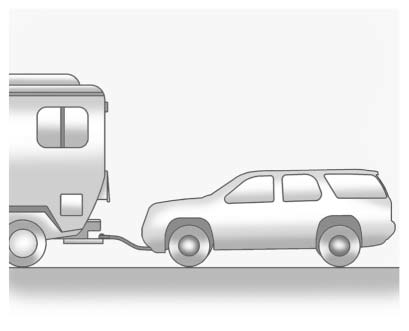
2. Secure the vehicle to the towing vehicle.
3. Set the parking brake.
4. Turn the ignition to ACC/ACCESSORY.
5. Shift the transmission to N (Neutral).
6. To prevent the battery from draining while the vehicle is being towed, remove
the 15 amp ECM fuse and the 50 amp BATT1 fuse from the underhood fuse block and
store in a safe location. See Engine Compartment Fuse Block .
7. Release the parking brake.
2. Reinstall the fuses in the underhood fuse block.
3. Shift the transmission to P (Park), turn the ignition to LOCK/OFF and remove
the key from the ignition.
4. Disconnect the vehicle from the towing vehicle.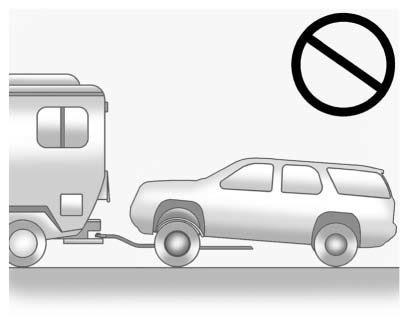
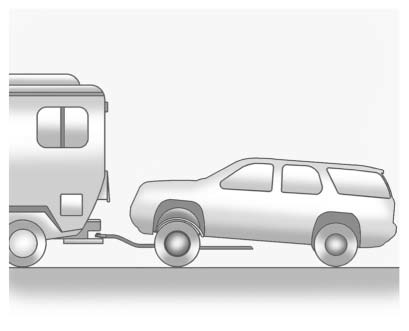
2. Move the shift lever to P (Park).
3. Set the parking brake.
4. Clamp the steering wheel in a straight-ahead position with a clamping device
designed for towing.
5. Remove the key from the ignition.
6. Secure the vehicle to the dolly.
7. Release the parking brake.